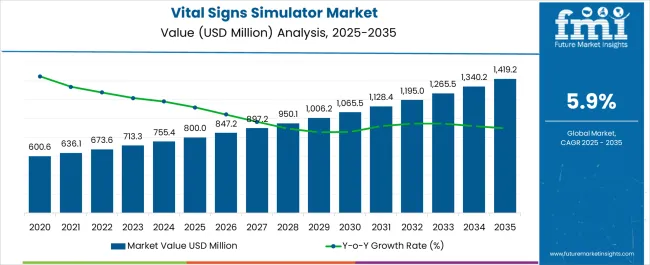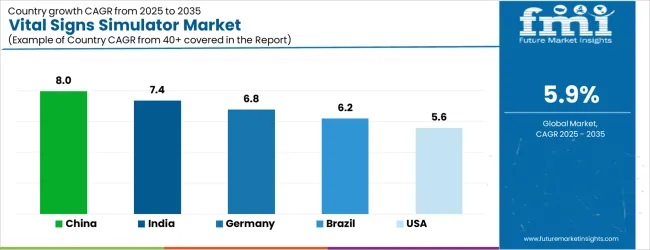The Vital Signs Simulator Market is estimated to be valued at USD 800.0 million in 2025 and is projected to reach USD 1419.2 million by 2035, registering a compound annual growth rate (CAGR) of 5.9% over the forecast period.

| Metric | Value |
|---|---|
| Vital Signs Simulator Market Estimated Value in (2025 E) | USD 800.0 million |
| Vital Signs Simulator Market Forecast Value in (2035 F) | USD 1419.2 million |
| Forecast CAGR (2025 to 2035) | 5.9% |
The Vital Signs Simulator market is experiencing steady growth driven by the increasing demand for advanced medical training solutions that enhance the skills of healthcare professionals. The future outlook for this market is shaped by the rising emphasis on patient safety, accurate diagnosis, and effective medical education programs. Hospitals and medical institutions are investing in simulators to provide hands-on experience in a controlled environment, reducing the risk of errors in real-life clinical settings.
The growing prevalence of chronic diseases and the need for skilled healthcare practitioners are further supporting market expansion. Continuous technological advancements in simulator devices, including software integration and realistic physiological modeling, are enhancing the effectiveness and usability of these systems. Additionally, rising awareness about the importance of continuous medical training and regulatory requirements for clinical competency assessments are propelling the adoption of vital signs simulators.
The market is also benefiting from the increasing focus on e-learning and simulation-based training programs, which allow institutions to standardize education and improve learning outcomes Overall, the market is poised for sustained growth as healthcare systems globally continue to prioritize training and patient safety initiatives.
The vital signs simulator market is segmented by end use, devices, and geographic regions. By end use, vital signs simulator market is divided into Hospitals, Emergency Care Centers, Ambulatory Centers, and Others. In terms of devices, vital signs simulator market is classified into Blood Pressure Monitor (Simulator), Heart Rate Simulator, Pulse Oximeters, and Others. Regionally, the vital signs simulator industry is classified into North America, Latin America, Western Europe, Eastern Europe, Balkan & Baltic Countries, Russia & Belarus, Central Asia, East Asia, South Asia & Pacific, and the Middle East & Africa.

The hospitals segment is projected to hold 45.0% of the Vital Signs Simulator market revenue share in 2025, making it the leading end-use category. This dominance is attributed to the high demand for training solutions that support clinical staff in monitoring and interpreting vital signs accurately. Hospitals are increasingly adopting simulators to enhance practical training for nurses, technicians, and doctors, ensuring patient safety and operational efficiency.
The growing complexity of healthcare procedures and the need for standardized training programs have further reinforced the adoption of vital signs simulators in hospital settings. Moreover, the segment has benefited from the integration of advanced simulator features that replicate realistic patient conditions, enabling healthcare professionals to practice critical decision-making in controlled environments.
Investments in modern healthcare infrastructure and increasing emphasis on reducing medical errors are key factors driving the prominence of this segment The hospitals segment is expected to continue leading due to its critical role in clinical training and the ongoing need for skilled medical practitioners.

The blood pressure monitor simulator sub-segment is expected to account for 40.0% of the Vital Signs Simulator market revenue share in 2025, establishing it as the leading device type. Growth in this sub-segment has been influenced by the widespread use of blood pressure monitoring in routine patient care, medical education, and clinical training programs. Simulators for blood pressure devices allow healthcare professionals to practice accurate measurement techniques, identify abnormal readings, and respond appropriately in real-life scenarios without risk to patients.
The rising prevalence of hypertension and cardiovascular disorders has heightened the need for effective training tools, supporting the adoption of blood pressure simulators. Additionally, the integration of software-based analytics and real-time feedback has improved the usability and educational value of these simulators.
Training programs increasingly emphasize competency in blood pressure monitoring, making this sub-segment a critical component of medical education and professional development The continued focus on patient safety and clinical skill enhancement is expected to drive sustained growth in this sub-segment.
Vital Sign simulator is the device which is widely used for various applications in healthcare industry. As the healthcare domain is the most critical domain when it comes to the accuracy of test results provided by monitoring equipments, the demand for vital Sign simulator is considerably high as it is mandatory to test results of the patient accurately to diagnose any health issues.
Healthcare monitoring equipments play critical role in healthcare facilities for ensuring the accuracy of the results on regular basis. Another factor which contributes to the growth of these vital Sign simulator is the innovations in healthcare softwares and devices in the last few years. Vital Sign simulator has wide range of applications, like monitoring of ECG, respiration, cardiac output, blood pressure and other vital parameters.
The precise and quick results offered by vital Sign simulator in healthcare industry is boosting the growth of the market.

| Country | CAGR |
|---|---|
| China | 8.0% |
| India | 7.4% |
| Germany | 6.8% |
| Brazil | 6.2% |
| USA | 5.6% |
| UK | 5.0% |
| Japan | 4.4% |
The Vital Signs Simulator Market is expected to register a CAGR of 5.9% during the forecast period, exhibiting varied country level momentum. China leads with the highest CAGR of 8.0%, followed by India at 7.4%. Developed markets such as Germany, France, and the UK continue to expand steadily, while the USA is likely to grow at consistent rates. Japan posts the lowest CAGR at 4.4%, yet still underscores a broadly positive trajectory for the global Vital Signs Simulator Market. In 2024, Germany held a dominant revenue in the Western Europe market and is expected to grow with a CAGR of 6.8%. The USA Vital Signs Simulator Market is estimated to be valued at USD 282.7 million in 2025 and is anticipated to reach a valuation of USD 282.7 million by 2035. Sales are projected to rise at a CAGR of 0.0% over the forecast period between 2025 and 2035. While Japan and South Korea markets are estimated to be valued at USD 40.7 million and USD 22.5 million respectively in 2025.

| Item | Value |
|---|---|
| Quantitative Units | USD 800.0 Million |
| End Use | Hospitals, Emergency Care Centers, Ambulatory Centers, and Others |
| Devices | Blood Pressure Monitor (Simulator), Heart Rate Simulator, Pulse Oximeters, and Others |
| Regions Covered | North America, Europe, Asia-Pacific, Latin America, Middle East & Africa |
| Country Covered | United States, Canada, Germany, France, United Kingdom, China, Japan, India, Brazil, South Africa |
| Key Companies Profiled | Laerdal Medical, Gaumard Scientific Company, Simulab Corporation, Fluke Biomedical, Rigel Medical, Koken, Pronk Technologies, and Gossen Metrawatt |
The global vital signs simulator market is estimated to be valued at USD 800.0 million in 2025.
The market size for the vital signs simulator market is projected to reach USD 1,419.2 million by 2035.
The vital signs simulator market is expected to grow at a 5.9% CAGR between 2025 and 2035.
The key product types in vital signs simulator market are hospitals, emergency care centers, ambulatory centers and others.
In terms of devices, blood pressure monitor (simulator) segment to command 40.0% share in the vital signs simulator market in 2025.






Our Research Products

The "Full Research Suite" delivers actionable market intel, deep dives on markets or technologies, so clients act faster, cut risk, and unlock growth.

The Leaderboard benchmarks and ranks top vendors, classifying them as Established Leaders, Leading Challengers, or Disruptors & Challengers.

Locates where complements amplify value and substitutes erode it, forecasting net impact by horizon

We deliver granular, decision-grade intel: market sizing, 5-year forecasts, pricing, adoption, usage, revenue, and operational KPIs—plus competitor tracking, regulation, and value chains—across 60 countries broadly.

Spot the shifts before they hit your P&L. We track inflection points, adoption curves, pricing moves, and ecosystem plays to show where demand is heading, why it is changing, and what to do next across high-growth markets and disruptive tech

Real-time reads of user behavior. We track shifting priorities, perceptions of today’s and next-gen services, and provider experience, then pace how fast tech moves from trial to adoption, blending buyer, consumer, and channel inputs with social signals (#WhySwitch, #UX).

Partner with our analyst team to build a custom report designed around your business priorities. From analysing market trends to assessing competitors or crafting bespoke datasets, we tailor insights to your needs.
Supplier Intelligence
Discovery & Profiling
Capacity & Footprint
Performance & Risk
Compliance & Governance
Commercial Readiness
Who Supplies Whom
Scorecards & Shortlists
Playbooks & Docs
Category Intelligence
Definition & Scope
Demand & Use Cases
Cost Drivers
Market Structure
Supply Chain Map
Trade & Policy
Operating Norms
Deliverables
Buyer Intelligence
Account Basics
Spend & Scope
Procurement Model
Vendor Requirements
Terms & Policies
Entry Strategy
Pain Points & Triggers
Outputs
Pricing Analysis
Benchmarks
Trends
Should-Cost
Indexation
Landed Cost
Commercial Terms
Deliverables
Brand Analysis
Positioning & Value Prop
Share & Presence
Customer Evidence
Go-to-Market
Digital & Reputation
Compliance & Trust
KPIs & Gaps
Outputs
Full Research Suite comprises of:
Market outlook & trends analysis
Interviews & case studies
Strategic recommendations
Vendor profiles & capabilities analysis
5-year forecasts
8 regions and 60+ country-level data splits
Market segment data splits
12 months of continuous data updates
DELIVERED AS:
PDF EXCEL ONLINE
Vital Signs Monitoring Devices Market Analysis - Trends & Forecast 2025 to 2035
Non-Magnetic Vital Signs Monitoring Systems Market
GNSS Simulator Market Forecast Outlook 2025 to 2035
Drone Simulator Market Size and Share Forecast Outlook 2025 to 2035
Radar Simulators Market Size and Share Forecast Outlook 2025 to 2035
Solar Simulator Market Trends - Growth, Demand & Forecast 2025 to 2035
Gaming Simulators Market Size and Share Forecast Outlook 2025 to 2035
Dental Simulator Market Analysis - Growth, Trends & Forecast 2025 to 2035
Flight Simulator Market Report – Trends & Forecast 2020-2030
Network Simulator Software Market Size and Share Forecast Outlook 2025 to 2035
Driving Simulator Market
Satellite Simulator Market Size and Share Forecast Outlook 2025 to 2035
Human Torso Simulator Market Size and Share Forecast Outlook 2025 to 2035
Reference Designs Market Growth - Trends & Forecast 2025 to 2035
Ship Bridge Simulator Market
Driving Test Simulator Market Size and Share Forecast Outlook 2025 to 2035
Power System Simulator Market Growth - Trends & Forecast 2025 to 2035
Radar Message Signs Market Size and Share Forecast Outlook 2025 to 2035
Artificial Ear Simulator Market Size and Share Forecast Outlook 2025 to 2035
Ginseng Extract Skin Revitalizers Market Analysis - Size, Share, and Forecast Outlook 2025 to 2035

Thank you!
You will receive an email from our Business Development Manager. Please be sure to check your SPAM/JUNK folder too.
Chat With
MaRIA